Getting the most production value out of grazing winter cereals
13 Jul 2021
Grazing winter cereal crops can help overcome winter feed shortages, but producers need to consider some animal health issues, advises North Coast Local Land Services.
Senior Land Services Officer, Agronomy James Geary Said, ‘Although they have higher winter growth rates than most pastures, and higher carrying capacity, cereal crops can be deficient in critical minerals, particularly calcium and magnesium.’
The high potassium found in cereal crops and other lush pastures can inhibit calcium and magnesium uptake, making deficiencies in these minerals even more likely on a cereal crop.
District Veterinarian Ian Poe Said, ‘Calcium is important for nerve function, muscle contraction, blood clotting and bone formation. A deficiency can result in milk fever in lactating stock. Magnesium is needed to metabolise carbohydrates, lipids and protein. A deficiency is known as “grass tetany”, and symptoms include excitability, aggression convulsions, tremors, stiffness and death.’
Pulpy kidney is also encountered when grazing cereal crops. Like other winter pastures, they can be high in water-soluble carbohydrates, which causes an overgrowth of Clostridal bacteria in the gut and the subsequent death of the animal.
‘Generally, if grazing cereal crops, it is important to continually supplement stock with a source of calcium, salt, and magnesium while grazing. Fortunately, supplementing stock with calcium and magnesium is pretty cheap and easy.’ Said, James.
‘Producers should vaccinate for pulpy kidney before putting stock out on cereal crops and introducing livestock slowly to the new diet will help avoid other animal health risks, such as nitrate poisoning.’ Said, Ian.
If it’s not possible to gradually introduce livestock to a new diet, it’s vital to ensure a roughage source is available in the paddock, such as medium to good quality hay.
Provided that crop and livestock management is up to scratch, winter cereals can be grazed successfully.
If you need advice about grazing winter cereals, mineral supplementation or vaccinating your cattle, you can call us on 1300 795 299. Or check out the NSW DPI Primefact on grazing cereals here.
ENDS
Media contact: Emily Findlay, M: 0419221136 North Coast Local Land Services.
Image Caption: Cereal crops can be deficient in key minerals, particularly calcium and magnesium, fortunately, supplementing stock with calcium and magnesium is cheap and easy.
Notes for Editors
North Coast Local Land Services recommends:
- Offering a 1:1 mix of Causmag® and salt for growing livestock, a 2:2:1 mix of limestone, salt and Causmag® for pregnant and lactating livestock or a 1:1 mix of lime and salt for pregnant and lactating livestock that find the Causmag® unpalatable.
- A booster vaccine to protect against pulpy kidney (for example ‘5-in-1’ or ‘7-in-1’) a couple of weeks before livestock go out onto a crop and introducing livestock slowly to the new diet to avoid adverse animal health risks, such as nitrate poisoning.
- Getting stocking rate right is very important. Strip grazing will reduce wastage due to trampling, may decrease weed competition and can increase animal impact on the soil, but it can also reduce livestock production as stock will always select the best feed on offer.
